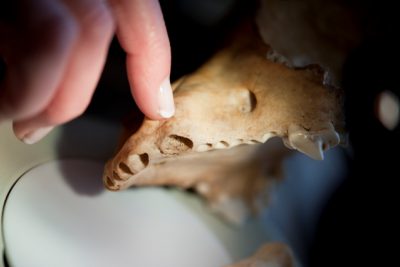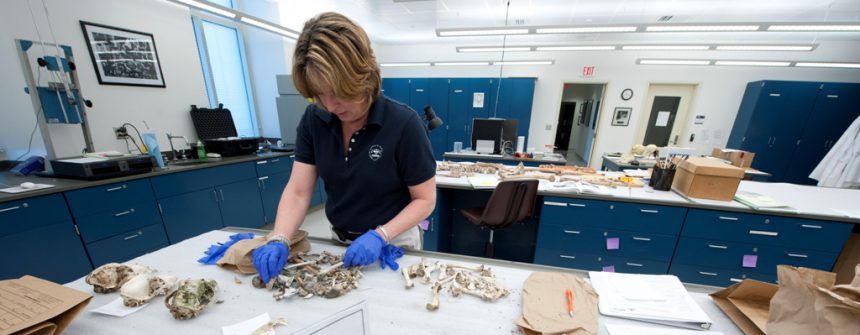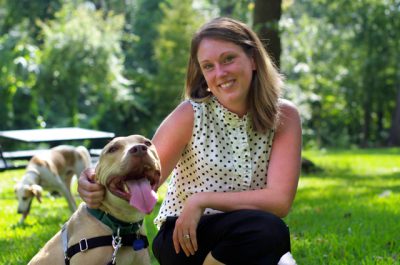Melinda Merck (DVM '88) and Rachel Touroo (DVM '07)

DRUGS, GUNS, AND GAMBLING—these are criminal activities that often accompany dog and cock fighting. Pets with recurrent signs of abuse, including fractures and broken bones, often point to domestic violence. Animal neglect may signal child or elder neglect. These links between crimes against animals and crimes against humans are part of what make animal cruelty a public health issue.
Forensic veterinarians have helped solve crimes, provided data used to advocate for stronger animal cruelty laws, and trained law enforcement officials and veterinarians. Stronger laws and more aggressive prosecution of crimes against animals are tangible results that make it possible for forensic professionals to conduct the sometimes devastating work of investigating cruelty.
MSU alumnae Melinda Merck and Rachel Touroo are prominent figures in this field.
Beyond the Status Quo
MELINDA MERCK (DVM ’88)
For more than a decade, Melinda Merck has been shaping the field of veterinary forensics. From Cobb County, Georgia, to Christchurch, New Zealand, she has trained veterinary and law enforcement professionals on the application of veterinary medical knowledge to the investigation and prosecution of animal cruelty cases.

Merck was the first forensic veterinarian at the American Society for the Prevention of Cruelty to Animals(ASPCA) and helped launch the veterinary forensic science training program for the University of Florida—the first of its kind. Merck’s focus now is animal welfare as a global problem and she sits on the World Small Animal Veterinary Association’s Animal Wellness and Welfare Committee. She works internationally and says there is a lot that professionals in the United States can learn from experts in other countries.
Legislative change in British Columbia was an outcome of one of the world’s largest animal cruelty cases. Merck served on a team that included British Columbia SPCA constables, veterinarians, and forensic scientists. They exhumed and gathered evidence at the mass grave of nearly 100 sled dogs that had been owned by a sled dog tour operator and were inhumanely killed and dumped in 2010 after a post-Olympics downturn in business. The team’s months-long investigation produced a report of more than 1,000 pages that was central to legislative changes and to successful prosecution of the case. British Columbia now has the toughest animal cruelty laws anywhere in Canada.
“In Scotland, there is a country wide initiative to train veterinarians to recognize signs of violence and cruelty that are connected to domestic abuse,” says Merck. “The effort includes social scientists—they bring important skills like training veterinarians how to approach the topic of abuse with clients.”
“My commitment to change? I can tie it all back to MSU,” says Merck. “I learned ethics from Dr. Richard Walshaw and Dr. Sally Walshaw. They urged us to challenge the status quo, to think about animal welfare, and to remember that what we do is about the animals.”
Signs of evidence
RACHEL TOUROO (DVM ’07)
ON A CRIME SCENE, one of a forensic veterinarian’s roles is triaging animals—identifying animals that need to be stabilized before transport and preserving material and medical evidence before animals leave the scene. For instance, identifying dehydration can be important for cruelty or neglect cases, and this needs to be determined before the animal is hydrated.

“We don’t want to lose that evidence—it’s a potential charge of animal cruelty if an animal has been deprived of sustenance,” says Rachel Touroo, director of veterinary forensics at the American Society for the Prevention of Cruelty to Animals (ASPCA) since March 2012. “We also help identify items that law enforcement may not necessarily recognize as evidence, like wash bins or medications and supplements administered to dogs used in fighting.”
She assists with crime scene investigations in animal cruelty cases throughout the United States and provides expertise onsite and during the subsequent stages of investigation and prosecution. Her role as a forensic veterinarian includes examining deceased animals and writing forensics reports, which can be critical to a conviction.
Training and educating members of law enforcement and the veterinary community about cruelty and abuse are important to her role with the ASPCA. She sees a lack of awareness in the veterinary profession because recognizing abuse is not part of the typical curriculum.
Touroo knows firsthand how unaware veterinarians can be. Just out of school and in private practice, she had a patient that was coming in with fractures—what she now knows can be a sign of abuse. Touroo says that she did not know the signs at the time but the case haunts her, particularly because there were children in the home. She had no training on recognizing abuse or on the relationship between animal abuse and human abuse.
She is now working to change that gap in the common curriculum. Touroo’s position at the ASPCA is affiliated with the ASPCA Veterinary Forensic Sciences Program at the University of Florida, where she teaches two courses for the veterinary forensics certificate program.
“We hope to serve as an example of how to include forensics in the curriculum across the board,” she says of the program.
December 2013
Casey Williamson
